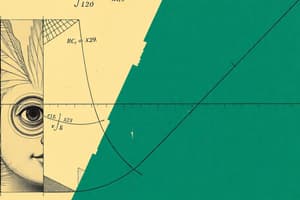Podcast
Questions and Answers
What is the difference between convergent and divergent sequences?
What is the difference between convergent and divergent sequences?
Convergent sequences approach a specific limit as they progress, while divergent sequences do not approach any limit.
What does the Sandwich Theorem state in the context of sequences?
What does the Sandwich Theorem state in the context of sequences?
The Sandwich Theorem states that if a sequence is 'sandwiched' between two convergent sequences, it also converges to the same limit.
Define the p-series and its condition for convergence.
Define the p-series and its condition for convergence.
A p-series is of the form $ rac{1}{n^p}$, and it converges if $p > 1$ and diverges if $p eq 1$.
What distinguishes an improper integral of Type-2 from Type-1?
What distinguishes an improper integral of Type-2 from Type-1?
What is the significance of eigenvalues and eigenvectors in matrix theory?
What is the significance of eigenvalues and eigenvectors in matrix theory?
Explain how the chain rule is applied in multivariate calculus.
Explain how the chain rule is applied in multivariate calculus.
What is a Fourier series and where is it commonly used?
What is a Fourier series and where is it commonly used?
Flashcards
Convergent sequence
Convergent sequence
A sequence is convergent if its terms approach a finite limit as the number of terms increases. If the limit does not exist or is infinite, the sequence is divergent.
Monotonic sequence
Monotonic sequence
A sequence is monotonic if its terms either always increase (increasing) or always decrease (decreasing). A sequence that is both increasing and decreasing is considered constant.
Bounded sequence
Bounded sequence
A sequence is bounded if there is a finite number that is greater than or equal to all the terms in the sequence (upper bound) and another finite number that is less than or equal to all the terms (lower bound).
Sandwich Theorem
Sandwich Theorem
Signup and view all the flashcards
Geometric Series
Geometric Series
Signup and view all the flashcards
nth-term test
nth-term test
Signup and view all the flashcards
Improper integral
Improper integral
Signup and view all the flashcards
Study Notes
Unit 1: Sequences and Series
- Convergent and Divergent Sequences: Sandwich Theorem, Bounded sequences, Monotonic sequence theorem, Geometric series, P-series.
- Limit Comparison Test: Ratio test, Root test, Alternating series test.
- Improper Integrals: Type 1, Type 2, improper integral type 3, converging/diverging integrals.
- Beta and Gamma functions: Definition of beta and gamma functions.
Unit 2: Fourier Series
- Fourier Series Expansion: Definition of order, degree, exact and non-exact equations, Linear and non-linear Fourier series, Fourier sine and cosine series, (Half range sine and cosine series)
Unit 3: Multivariate Calculus
- Limits, Continuity: Limits and continuity in multivariate calculus.
- Partial Derivatives: Chain rule, implicit differentiation, Euler's and Modified Euler's Theorem & examples for maxima, minima, tangent planes and normal lines.
Unit 4: Matrices
- Matrices (Systems of Linear Equations): Systems of linear equations, non-homogeneous and homogeneous systems, rank, finding eigenvalues and eigenvectors, algebraic and geometric multiplicity of eigenvalues, diagonalization.
- Nature of Quadratic Forms (Q.F.): Nature, classification and diagonalization of quadratic forms (Q.F.)
Studying That Suits You
Use AI to generate personalized quizzes and flashcards to suit your learning preferences.




